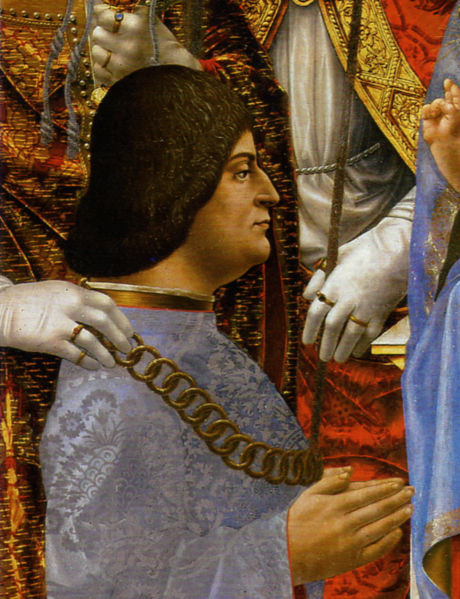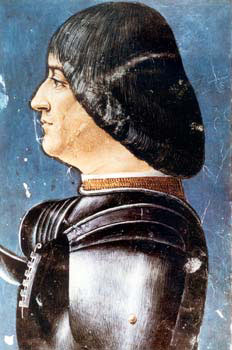<Back to Index>
- Physicist Loránd Eötvös de Vásárosnamény, 1848
- Poet Giosuè Alessandro Michele Carducci, 1835
- Duke of Milan Ludovico Sforza, 1452
PAGE SPONSOR


Ludovico Sforza Duke of Milan (Ludovico il Moro, "The Moor"; 27 July 1452 – 27 May 1508), a member of the Sforza dynasty of Milan, Duchy of Milan, was the fourth son of Francesco Sforza, and was famed as patron of Leonardo da Vinci and other artists and presided over the final and most productive stage of the Milanese Renaissance. He is probably best known as the man who commissioned the Last Supper.
Ludovico Sforza, born on July 27, 1452, at Vigevano, in what is now Lombardy, was the fourth son of Francesco I Sforza and Bianca Maria Visconti and, as such, was not expected to become ruler of Milan. Nevertheless his mother, Bianca, prudently saw to it that his education was not restricted to the classical languages. Under the tutelage of the humanist Francesco Filelfo, Ludovico received instruction in the beauties of painting, sculpture, and letters, but he was also taught the methods of government and warfare.
When Francesco died in 1466, he was succeeded by the dissolute Galeazzo Maria, elder brother of Ludovico. The former ruled till his assassination in 1476, leaving his throne to his 7 year old son, Gian Galeazzo Sforza, Ludovico's nephew. A bitter struggle for the regency with the boy's mother, Bona of Savoy, followed, from which Ludovico emerged the victor in 1481 and seized control of the government of Milan, despite attempts to keep him out of power. For the next 13 years he controlled Milan as regent.
In January 1491, he married Ercole I d'Este's youngest daughter Beatrice d'Este in a double Sforza-Este marriage, while Beatrice's brother, Alfonso d'Este, married Anna Sforza, his sister. Leonardo da Vinci orchestrated the wedding celebration. Beatrice and Alfonso’s sister, Isabella d'Este (1475 – 1497) was married to Francesco II Gonzaga, Marquess of Mantua. The 15 year old princess quickly charmed the Milanese court with her joy in life, her laughter, and even her extravagance. She helped to make the Sforza castle a center of sumptuous festivals and balls and she loved entertaining philosophers, poets, diplomats, and soldiers. Beatrice had good taste, and it is said that under her prompting her husband's patronage of artists became more selective and the likes of Leonardo da Vinci and Donato Bramante were employed at the court. She would become the mother of Maximilian Sforza and Francesco II Sforza, future Dukes of Milan.
Despite his marriage, Ludovico had at least two mistresses. Cecilia Gallerani was his favourite. She gave birth to his child, a son Cesare, on 3 May 1491, in the same year that he married Beatrice d'Este. Gallerani is thought to be the subject of Leonardo da Vinci's Lady with an Ermine – the ermine was the heraldic animal of Ludovico il Moro. Another mistress was Lucrezia Crivelli, who bore him another illegitimate son, Giovanni Paolo, born in the year of Beatrice's death. Giovanni Paolo became a successful condottiero and the first in the family line of the marquesses of Caravaggio.
Ludovico
contented himself with the realities rather than the appearance of
power. He invested in agriculture, horse and cattle breeding, and the
metal industry. Some 20,000 workers were employed in the silk industry. Artists and craftsmen labored to make the court of Milan the most splendid in Italy. Lodovico continued work on the Cathedral of Milan and had the streets of his capital widened and adorned with gardens. The universities of Pavia and
Milan flourished under him. There was some grumbling at the heavy
taxation necessary to support these ventures, and a few riots resulted. In 1494 the new king of Naples, Alfonso, allied himself with Pope Alexander VI, posing a threat to Milan. Ludovico decided to fend him off using France, then ruled by the powerful Charles VIII,
as his ally. He permitted the French troops to pass through Milan so
that they might attack Naples. However Charles's ambition was not
satisfied with Naples, and he subsequently laid claim to Milan itself.
Bitterly regretting his decision, Ludovico then entered an alliance with Maximilian I, Holy Roman Emperor, by offering him in marriage his niece Bianca Sforza and receiving, in return, imperial investiture of the duchy and joining the league against France. Gian
Galeazzo, his nephew, died under suspicious conditions in 1495, and the
throne of Milan fell to Ludovico, who hastened to assume the ducal
title and received the ducal crown from the Milanese nobles on 22
October. But by then, his luck seemed to have run out. On the 3rd of
January 1497, as the result of a difficult child-birth, Beatrice, his
wife, died. Ludovico was inconsolable, and the entire court was
shrouded in gloom. Ludovico had also hoped that by involving France, and the Holy Roman Emperor, Maximilian I, in Italian politics, he could manipulate the two and reap the rewards himself, and was thus responsible for starting the Italian Wars. At first, Ludovico defeated the French at the Battle of Fornovo in 1495 (making weapons from 80 tons of bronze originally intended for Leonardo da Vinci's equestrian statue of the duke). However, with the death of Charles, the French Throne was inherited by his cousin, Louis of Orléans, who became Louis XII of France. The new king had a hereditary claim to Milan, as his paternal grandmother was Valentina Visconti, daughter of Giangaleazzo Visconti,
the first Duke of Milan. Hence in 1498 he descended upon Milan. As none
of the other Italian states would help the ruler who had invited the
French into Italy 4 years earlier, Louis was successful in driving out
Ludovico from Milan. Ludovico managed to escape the French armies and,
in 1499, sought help from Maximilian and meanwhile the French had
entered Milan. Ludovico returned with an army of mercenaries and reentered Milan in February 1500. Two months later, Louis XII laid siege to the city of Novara, where Ludovico was based. The armies of both sides included Swiss mercenaries.
The Swiss did not want to fight each other and chose to leave Novara.
Ludovico was handed over to the French in April 1500. Deprived of all
the amenities of life, he spent his last years in the underground
dungeon at Loches, where he died on May 17, 1508. The Swiss later
executed a soldier from Uri,
called Hans Turmann, who had, they claimed, betrayed Ludovico for
money. The Swiss later restored the duchy of Milan to Ludovico's son, Maximilian Sforza. His other son, Francesco II, also held the Duchy of Milan for a short period.
It is said that he was called il Moro because of his dark complexion. Some scholars believe that the name Moro came
from Ludovico's coat of arms, which contained the mulberry tree, but
that is doubtful, as the Italian name for that tree is the feminine mora rather than the masculine moro. In Italian "moro", just like "bruno", is the masculine equivalent of "brunette" ("mora" in Italian). So the epithet most likely refers either to Ludovico's jet black hair or perhaps his swarthy complexion (suggesting he resembled a Moor).